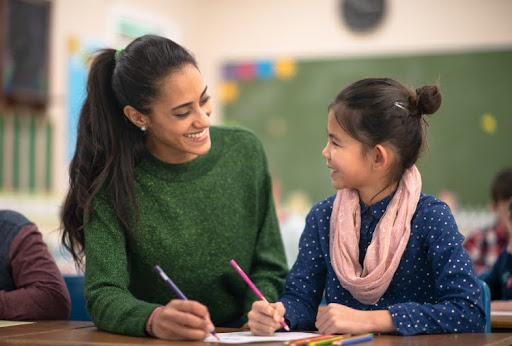The quality of a student’s learning environment can help determine whether or not they excel academically and socially. In fact, research published in Frontiers in Psychology in 2022 found that a student’s positive attitude about their learning environment can improve their outcomes in areas that range from their performance in school to their engagement with classwork.
Considering the proven impact of positive learning environments, it’s no surprise that advanced education degree programs — such as Master of Education (MEd) in Instruction degree programs — highlight methods for creating these environments.
But what comprises a positive learning environment? And how can teachers ensure they’re offering the type of support that puts their students in the best position to succeed? From providing comfortable physical surroundings to establishing clear classroom rules, teachers can take steps to create a learning environment that breeds success.
What Is a Positive Learning Environment?
Put simply, a positive learning environment is one that encourages learning. It encompasses not only students’ physical surroundings but the behavior and attitudes of those who interact with them. Among the characteristics of a positive learning environment are:
- Respect among students and educators, to encourage confidence and participation
- Comfortable seating and room temperature, to facilitate learning without distraction
- Adequate lighting, to allow for viewing materials and board work
- Plentiful classroom materials and supplies, to ensure that all students have the tools they need to learn
- Organized materials and classroom setup, to encourage orderly behavior and classwork
- Appropriate technology, to provide opportunities to learn with the latest digital tools
- Encouragement for independence and creativity, to foster individualized learning
- Focus on positive behaviors, to highlight students’ achievements and encourage further growth
- Active classroom discussions, to teach collaboration and the sharing of ideas
The Importance of a Positive Classroom Environment
There is a reason that positive learning environments can lead to better academic and social outcomes: These settings encourage students to be more engaged in learning and to develop a positive attitude about themselves and their work. Positive learning environments are what can make students more likely to:
- Strengthen their self-esteem through positive reinforcement that emphasizes their accomplishments and encourages their creativity
- Form relationships through collaborative learning that involves students as well as teachers and other adults
- Build confidence through support that allows for mistakes and the sharing of new ideas
- Gain a love of learning through experiences that students genuinely enjoy
How to Create a Positive Learning Environment
Educators who want to create a positive learning environment for students need to focus on certain key areas, such as:
- Quality of materials: Lessons should seem relevant to students and take into account their beliefs and customs.
- Clarity of rules: Students should have a firm understanding of the expectations for their classwork and behavior.
- Types of support: Teachers should help students develop confidence about their schoolwork and bolster their emotional and social development.
- Comfort of the environment: Students should have the opportunity to learn without disruptions.
- Emphasis on relationships: Educators should establish ties with students and their parents or other guardians.
Creating a Positive Learning Environment: What to Avoid
When considering how to create a positive learning environment, educators need to know that it’s about more than just what to do. It’s also about what to avoid. After all, the behaviors and physical surroundings that are detrimental to students’ learning can be just as significant as those that enhance it.
Dangers of a Negative Learning Environment
When a learning environment lacks the academic, emotional or physical support that helps students succeed, it can lead to any of a variety of negative outcomes. Among the potential problems that arise from negative learning environments are:
- High stress levels for students and teachers, which can result from a lack of clarity and support
- Confusion among students about expectations, leading to frustration and behavioral problems
- Lack of connection between students, educators and parents, which can occur when teachers don’t build strong relationships
Avoiding a Negative Learning Environment
To protect against the negative outcomes that can occur when students don’t receive the proper support, teachers should avoid actions such as:
- Failing to encourage student interaction during instruction
- Failing to focus on a sense of belonging among students, teachers, staff and parents
- Failing to provide an environment that is conducive to focused learning, whether it is an in-person learning environment, a remote learning environment or both
10 Positive Learning Tips for Teachers
Teachers can take a variety of steps to facilitate positive learning for their students. Following are 10 tips for teachers who want to create a positive learning environment.
1. Focus on Relationships
To help foster the camaraderie that plays a vital role in enhancing student learning, teachers should work to develop relationships with the students in their class as well as the parents and other caregivers who support them. They also should help students learn how to interact with their peers in ways that show empathy and respect. Some ways teachers can build relationships are:
- Greet each student as they arrive for class each day.
- Ask questions about topics students are interested in.
- Incorporate student collaboration in lessons.
- Communicate frequently with parents and other guardians about classroom rules and students’ achievements.
2. Ensure Comfortable Physical Surroundings
Whether the class is in person, remote or some combination of the two, students and teachers need an organized and calm environment that inspires them to do their best work. Among the ways teachers can make sure their surroundings are conducive to learning are:
- Take advantage of tools, like classroom bins or online applications, that keep classroom materials accessible and in order.
- Aim to keep a supply of books and other materials available to accommodate all students’ needs.
- Post colorful decorations with motivational messages, and consider involving students in decision-making about the room design.
- Arrange desks and other learning spaces in ways that allow for focus or collaboration, as appropriate.
3. Provide Set Rules
Teachers should create a set of class rules — and communicate those rules clearly to students and their families. Then, to best support a positive learning environment, educators should focus on rewarding students for behaviors that are in line with this code of conduct. Tips for establishing, communicating and enforcing rules include:
- Set high expectations for student behavior, sharing those guidelines in ways that focus on what to do instead of what not to do.
- Share information about class rules with students’ guardians, and note ways that families can reinforce their importance.
- Celebrate successes in following class rules.
4. Establish Clear Goals
Just as expectations for classroom behavior should be high, goals for students’ achievement should encourage strong academic and social growth. Some tips for establishing and reaching these goals are:
- Consider all students as capable of making great strides in their learning and development, regardless of any challenges they might face.
- Deliver lessons that include games or other activities that motivate students to perform their best.
- Regularly assess student and class progress toward established goals, and conduct teacher self-assessments to determine areas for instructional improvement.
5. Reward Positive Behaviors
Emphasizing positive behaviors and outcomes, instead of focusing on the negative, helps to create a positive learning environment. Some ways teachers can shine the spotlight on positivity are:
- Provide age-appropriate prizes, from stickers to a few moments of free time, clearly connecting the reward to the behavior.
- Use positive language when interacting with students and parents, emphasizing what is good instead of what is wrong.
- Model positive behaviors around students, parents and colleagues.
6. Make Learning Relatable
Adapting lessons to students’ own interests, talents and learning styles helps to ensure that students can relate to the material — and absorb the concepts it’s teaching. Tips that can make lessons more relatable to students are:
- Encourage students to ask questions that can help guide the conversation and focus on their interests.
- Explore ways to use real-world examples of a concept being taught, and encourage students to find instances of the concept in their own lives.
- Solicit students’ input on which lessons they want to learn about a particular topic.
7. Incorporate Cultural Relevance
Teachers should embrace cultural diversity and encourage acceptance by seeking to understand their students’ different lived experiences. When they learn about their students’ cultures, traditions and languages, educators can use that knowledge to design lessons that take class members’ differences into account when presenting lessons. A few tips for practicing culturally responsive teaching are:
- Find ways to tie lessons to the cultural traditions of class members.
- Reference diverse cultures when providing examples or story problems.
- Use media that portray different cultures in a positive light.
8. Foster Collaboration
To help students develop their social skills while learning from each other, teachers should encourage collaboration among those in their class. Some tips to foster collaboration in the classroom are:
- Incorporate group work into lessons.
- Focus on developing collaborative skills such as through brainstorming and sharing ideas.
- Model collaborative behavior with colleagues.
9. Offer Personalized Feedback
Providing feedback that addresses each student’s own accomplishments and areas for improvement is a good way to connect with students while helping them to gauge their progress. It also makes it more likely that students will internalize the message being delivered. Some tips for providing feedback to students are:
- Respond promptly to allow students to quickly make adjustments that guide their learning.
- Go beyond generalized comments, providing personalized messages that point out positive aspects of the student’s work.
- Encourage students to think critically about their own work and how they can improve it.
10. Become a Lifelong Learner
Staying abreast of the latest instructional research and techniques can help teachers ensure they are consistently providing a positive learning environment for their students. Among the tips for engaging in continual learning are:
- Attend education workshops and conferences.
- Exchange ideas with mentors and colleagues.
- Pursue a higher-level degree, such as a Master of Education in instruction.
Examples of Positive Learning Environments
Positive learning environments can occur in any type of educational setting, such as:
- In-person settings, in a classroom or other area of a school
- Remote settings, using a digital platform for instruction
- Blended settings, combining in-person and digital learning
Regardless of the setting, positive learning environments feature the hallmarks of teaching practices that help students succeed, such as an emphasis on strong relationships and orderly surroundings. Following are examples of positive learning environments in three different types of settings.
In-Person Learning
Positive in-person learning environments — in settings such as classrooms, libraries and homes — are calm and free of disruptions like background noise.
The room setup should allow for clear viewing of materials that teachers and students present to the class. Assigning seats and following an established routine help students feel more comfortable because they know what to expect each day.
Additionally, personal touches in the space’s decorations, provided by both teachers and students, help to make the connections that can foster students’ success.
Remote Learning
In remote learning, instructors present educational materials digitally to students who are outside of a traditional classroom setting. While keeping students engaged and building personal relationships play a vital role in establishing a positive learning environment, doing so can be challenging when teachers and class members must rely primarily on digital devices to connect.
To encourage positive outcomes in digital settings, teachers can emphasize active learning that draws out students through activities they can perform online, such as:
- Participating in discussion boards
- Breaking into small groups for learning
- Using digital tools like videos, whiteboards and voice content that target a variety of learning styles
Blended Learning
Blended learning spaces also can provide examples of positive learning environments. Blended, or hybrid, instruction combines components of in-person learning and remote learning, taking place in a classroom setting but incorporating digital tools in teaching.
Because it features elements of both in-person and remote educational settings, blended learning presents opportunities to use the tools from both settings to encourage students to succeed. Among the ways to make blended learning settings positive learning environments are:
- Take advantage of a variety of digital methods, from interactive presentations to online search, to assist with instruction and build interest.
- Establish clear expectations among students and parents regarding the use of electronics in a classroom setting.
- Strike a balance between in-person activities, such as group work, and online opportunities, such as shared documents, that allow for collaboration.
Build a Positive Learning Environment for Your Students
If you’re ready to engage in the ongoing learning that helps teachers build their skills and stay up to date on the latest instructional techniques, explore Augusta University Online’s Master of Education in Instruction degree program. Through flexible online courses that allow you to continue teaching while pursuing your degree, you’ll learn how to build a positive learning environment for all students.
The program features a variety of concentrations focused on grade levels, student populations and academic subjects — from elementary education to special education and from physics to physical education — so you can target your learning to your own career interests.
Discover how AU Online’s MEd in Instruction degree program can help you achieve your professional goals.
Recommended Readings
5 Tips for Creating an Inclusive Learning Environment
How to Become an Educational Consultant
Remote Learning Resources for Students and Teachers
Sources:
Classroom Management Expert, “Blended Learning in Your Classroom: 25 Strategies and Best Practices”
Classroom Management Expert, “How to Promote Student Collaboration in the Classroom”
Classroom Management Expert, “Positive Classroom Environment: Why Is It Important?”
Classroom Management Expert, “Self-Care for Teachers: 25 Tips and Strategies”
Communities in Schools, “The Importance of Creating a Positive Learning Environment for Your Child”
Docebo, “8 Effective Ways to Make Online Learning More Engaging”
Education Corner, “Strategies for Building a Productive and Positive Learning Environment”
Educause, Learning Environments
ELearning Industry, “The Importance of Feedback in Personalized Learning”
Frontiers in Psychology, “The Relationship Between Student’s Perceptions of Their School Environment and Academic Achievement”
Heliyon, “The Effectiveness of Blended Learning on Students’ Academic Achievement, Self-Study Skills and Learning Attitudes: A Quasi-Experiment Student in Teaching the Conventions for Coordinates in the Plane”
Indeed, “13 Strategies to Improve Your Classroom Environment”
Learning Environments Research, “What Are the Key Elements of a Positive Learning Environment? Perspectives From Students and Faculty”
Prodigy, “13 Ways to Create a Positive Learning Environment in Your Classroom”
Prodigy, “Culturally Responsive Teaching: Examples, Strategies and Activities for Success”
SimpliTaught, “Positive Learning Environment Creation Tips for Teachers”
Social Science Space, “John Hattie on the Factors That Influence Learning in Schools”
TeacherPH, “How to Make Learning More Relevant for Students”
 Augusta University
Augusta University




